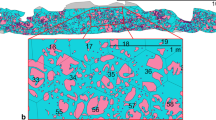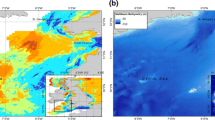Abstract
The development of a sampling design for optimisingsampling site locations collected from a coastalmarine environment has been the purpose of the presentwork; application of statistical analysis and spatialautocorrelation methods have been carried out. Thedataset included data collected from 34 sampling sitesspaced out in the Strait of Lesbos, Greece, arrangedin a 1×1 NM grid. The coastal shallow ecosystem wassubdivided into three zones, an inner one (7stations), a middle one (16 stations) and an offshorezone (11 stations). The standard error of thechlorophyll-a concentrations in each zone hasbeen used as the criterion for the sampling designoptimisation, resulting into reallocation of thesampling sites into the three zones. The positions ofthe reallocated stations have been assessed byestimation of the spatial heterogeneity and anisotropyof chlorophyll-a concentrations usingvariograms. Study of the variance of the initialdataset of the inner zone taking into account spatialheterogeneity, revealed two different sub-areas andtherefore, the number of the inner stations has beenreassessed. The proposed methodology eliminates thenumber of sampling sites and maximises the informationof spatial data from marine ecosystems. It isdescribed as a step-by-step procedure and could bewidely applied in sampling design concerning coastalpollution problems.
Similar content being viewed by others
References
Burrough, P. A.: 1996, Principles of Geographical Information Systems for Land Resources Assessment, Clarendon Press, Oxford.
Cantrell, R. S. and Cosner, S.: 1991, 'The effects of spatial heterogeneity in population dynamics', J. Math. Biol. 29, 315–338.
Cressie, N. A. C.: 1991, Statistics for Spatial Data, J. Wiley & Sons Inc., New York, 899 p.
Dutilleul, P.: 1993, 'Spatial heterogeneity and the design of ecological field experiments', Ecol. 74(6), 1646–1658.
Eleftheriou, A., Ansell, A. D. and Smith, C. J. (eds.): 1995, Biology and Ecology of Shallow Coastal Waters, Proceedings of the 28th Marine Biology Symposium 23rd-28th September 1993, Institute of Marine Biology of Crete, Iraklio, Crete, International Symposium Series, Olsen & Olsen, Fredensborg.
Fisher, R. A.: 1971, The Design of Experiments, 9th ed., Hafner, New York, U.S.A.
Frontier, S.: 1983, Stratégies d'échantillonnage en écologie, Masson,Québec, Presses de l'Université Laval, xvii, 494 p.
Giovanardi, F. and Tromellini, E.: 1992, 'An Empirical Dispersion Model for Total Phosphorus in a Coastal Area: The Po River Adriatic System', in: R. A. Vollenweider, R. Marchetti and R. Viviani (eds.), Marine Coastal Eutrophication, Elsevier Science Publications, London, pp. 201–210.
Gray, J. S., McIntyre, A. D. and Stirn, J.: 1992, Manual Methods in Aquatic Environment Research: Part II – Biological Assessment of Marine Pollution, Food and Agriculture Organization of the United Nations, Fisheries Technical Paper 324.
Lam, N. S.-N.: 1983, 'Spatial interpolation methods: a review', The American Cartographer 10(2), 129–149.
Legendre, L. and Demers, S.: 1985, 'Auxiliary energy, ergoclines and aquatic biological production', Naturaliste Can. (Quebec) 112, 5–14.
Legendre, P. and Troussellier, M.: 1988, 'Aquatic heterotrophic bacteria: modelling in the presence of spatial autocorrelation', Limnol. Ocean. 33(5), 1055–1067.
Legendre, P. and Fortin, M.-J.: 1989, 'Spatial pattern and ecological analysis', Vegetatio 80, 107–138.
Legendre, P., Troussellier, M., Jarry, V. and Fortin, M.-J.: 1989, 'Design for simultaneous sampling of ecological variables: from concepts to numerical solutions', Oikos 55, 30–42.
Legendre, P.: 1993, 'Spatial autocorrelation: trouble or new paradigm?', Ecol. 74(6), 1659–1673.
Levin, L. A.: 1984, 'Life history and dispersal patterns in a dense infaunal polychaete assemblage: community structure and response to disturbance', Ecol. 65, 1185–1200.
Li, H. and Reynolds, J. F.: 1994, 'A simulation experiment to quantify spatial heterogeneity in categorical maps', Ecol. 75(8), 2446–2455.
Lodge, D.M., Barko, J.W., Strayer, D., Melack, J.M., Mittelbach, G. G., Howarth, R.W., Menge, B. and Titus, J. E.: 1988, 'patial Heterogeneity and Habitat Interactions in Lake Communities', in: S. R. Carpenter (ed.), Complex Interactions in Lake Communities, Springer-Verlag, New York, U.S.A., pp. 181–208.
Mackas, D. L.: 1984, 'Spatial autocorrelation of phytoplankton community composition in a continental shelf ecosystem', Limnol. and Oceano. 29(3), 451–471.
Mason, R. L., Gunst, R. F. and Hess, J. L.: 1989, Statistical Design and Analysis of Experiments, J. Wiley & Sons Inc., New York, 692 p.
May, R. M.: 1974, Stability and Complexity in Model Ecosystems, 2nd ed., Princeton University Press, Princeton, NJ.
Mukai, T.: 1987, 'Effects of micro-scale gradients concerning water qualities on the structure of the phytoplankton community in a coastal embayment', Estuarine, Coastal and Shelf Sci. 25, 447–458.
Oliver, M. A. and Webster, R.: 1990, 'Kriging: A method of interpolation for geographical information systems', Inter. J. Geograph. Inform. Syst. 4(3), 313–332.
Pannatier, Y.: 1996, Statistics and Computing: Variowin, Software for Spatial Data Analysis in 2D, Springer-Verlag New York, Inc.
Parsons, T. R., Maita, Y. and Lalli, C. M.: 1984, A Manual of Chemical and Biological Methods for Seawater Analysis, Pergamon Press, New York.
Perez, L. and Canteras, J. C.: 1990, 'Spatial heterogeneity of phytoplankton in an estuary of Cantabria, northern Spain', J. Coastal Res. 6, 157–168.
Schneider, D. C.: 1994, Quantitative Ecology: Spatial and Temporal Scaling, Academic Press, San Diego, 295 p.
Sokal, R. R. and Rohlf, F. J.: 1981, Biometry: The Principles and Practice of Statistics in Biological Research, 2nd ed., W.H. Freeman and Company, New York, 859 p.
Troussellier, M., Lebaron, Ph., Baleux, B. and Got, P.: 1993, 'Spatial distribution patterns of heterotrophic bacterial populations in a coastal ecosystem (Thau basin, France)', Estuarine, Coastal and Shelf Sci. 36, 281–293.
Valiela, I.: 1995, Marine Ecological Processes, 2nd ed., Springer-Verlag, New York, Inc.
Washington, H. G.: 1984, 'Diversity, biotic and similarity indices. A review with special relevance to aquatic ecosystems', Water Res. 18, 653–694.
Author information
Authors and Affiliations
Corresponding author
Rights and permissions
About this article
Cite this article
Kitsiou, D., Tsirtsis, G. & Karydis, M. Developing an Optimal Sampling Design. A Case Study in a Coastal Marine Ecosystem. Environ Monit Assess 71, 1–12 (2001). https://doi.org/10.1023/A:1011639611549
Issue Date:
DOI: https://doi.org/10.1023/A:1011639611549




